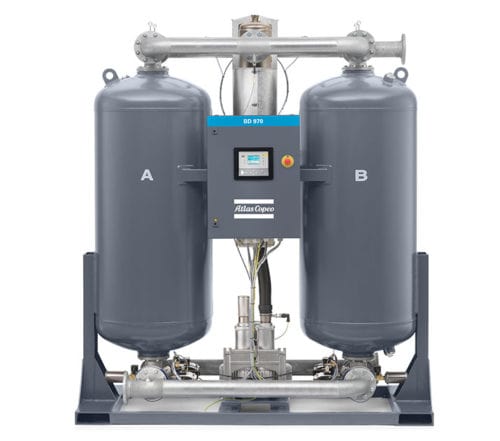Water vapor can have a negative impact on the integrity of a compressed air system. To avoid issues such as freezing, mold, and corrosion, facilities in a range of industries utilize compressed air dryer systems. However, with so many compressed air dryer types to choose from, it is important to understand the different properties of each, so you can choose the perfect solution for your application.
Types of Compressed Air Dryers
There are four major categories of compressed air dryers, each with their own unique strengths and weaknesses.
Refrigerated Air Compressor Dryers
Refrigerated air compressor dryers work by cooling the air to condense water vapor. Generally, they will produce dew points ranging from 35-40° F, and will be unable to achieve dew points below freezing. With less need for maintenance as well as lower operating costs, this is one of the more affordable compressed air dryer options.
There are two basic types of refrigerated dryers:
- Cycling: Cools compressed air until it reaches the desired temperature, then switches off. This option is more energy efficient.
- Non-Cycling: Constantly circulates refrigerant. This option is more responsive and produces more consistent dew points.
*In addition, with the advancement of variable speed drives, larger CFM dryers have begun incorporating VSD fan motors and coolant pump motors. This option will further reduce energy costs vs. the Cycling type of refrigerated dryer.
Regenerative Desiccant Air Compressor Dryers
Regenerative desiccant air compressor dryers utilize desiccant materials such as silica gel to remove water vapor. These systems will most frequently alternate air flow between two towers, giving the desiccant media time to dry after it has been saturated. The key feature that differentiates regenerative desiccant dryers is the fact that they can produce dew points as low as -100° F, drastically lower than other options.
There are four types of regenerative desiccant dryers:
- Heatless: Depends entirely on purge air rather than heaters to remove moisture.
- Heated: Combines purge air and heaters to dry desiccant media.
- Heated Blower Purge: A more efficient option that eliminates compressed purge air and utilizes a separate heated blower.
- Heat of Compression: Utilizes heat generated during compression to dry desiccant material.
*It is important to know the required dew point. Equipment costs for regenerative dryers are typically 2X or more than what a refrigerated dryer costs. If you do not need the deeper dew point stick with the refrigerated dryer.
Deliquescent Air Compressor Dryers
This system makes use of chemical media that absorb other media. Unlike desiccant dryers, the material within deliquescent dryers cannot be dried once it is saturated—it must be replaced. As there is no need for purge air in these systems, they are highly affordable and can provide energy savings of up to 20%. The typical deliquescent dryer requires no power to operate.
Membrane Air Compressor Dryers
Membrane air compressor dryers are composed of specialized membrane micro-tubes. As compressed air travels through the tubes, water vapor will diffuse through the permeable membrane. These systems can bring dew points down to -40° F. They are very quiet and have no moving parts. The membrane dryer does use purge air to dry the membrane, similar to a regenerative so expect a reduction of available downstream air of up to 15%.
Applications are typically limited to 120 CFM or less, but like the deliquescent dryer no power is needed to operate it.
Compressed Air Dryer Applications
As each type of compressed air dryer has different advantages, they are not all suited for every industry or application. Here are the areas where each system excels.
Refrigerated Air Compressor Dryers
Reliable, compact, and energy efficient, these dryers are ideal for any application where water vapor could inhibit workflow. They are common in many industries, including:
- Automotive/Autobody
- Metal Fabrication
- Machinery and Equipment Manufacturing
- Printing
- Rubber and Plastics Manufacturing
- Chemical
Regenerative Desiccant Air Compressor Dryers
Desiccant dryers are frequently used for mold prevention and material processing. As they can be somewhat expensive, these systems are best saved for applications requiring incredibly low dew points and dry air, such as medical air compressors, dry sprinkler systems, and laboratory analyzers. They are often found in the following industries:
- Pharmaceutical
- Healthcare
- Food Processing
- Fabric Production
Deliquescent Air Compressor Dryers
These dryers require no electricity and very little maintenance. They are popular in applications such as sand blasting and painting.
Membrane Air Compressor Dryers
Membrane dryers need no external power source, and can withstand high vibrations. They are ideal for compact mobile applications, particularly in outdoor or hazardous environments with fluctuating ambient temperatures.
Learn More About Compressed Air Dryers
Finding the proper compressed air dryer for your needs can reduce costs, improve the longevity of your equipment, and decrease the risk of mold. Since 1975, Airmatic Compressor has been providing expert service and dependable industrial air dryers. Contact us today for your air compressor dryer solution.


